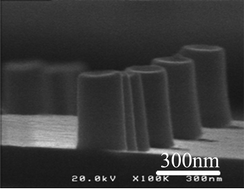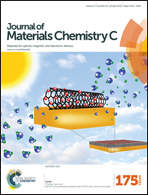Well-defined silicon patterns by imprinting of liquid silicon
Abstract
Well-defined silicon patterns with a high aspect ratio and sharp edges were directly formed by imprinting of liquid silicon which was synthesized via the photopolymerization of cyclopentasilane (CPS: Si5H10) with UV light. After the patterns were formed, they were converted into amorphous silicon patterns by post-annealing at 400 °C. Both dotted and lined patterns whose size ranges from 1 μm to 100 nm were obtained, suggesting that their size could be further reduced. It is very noteworthy that all the obtained patterns demonstrated a good aspect ratio and sharp edges, despite a large shrinkage of 70–80% during the process. By conducting solid-phase crystallization at 800 °C, the pattern portion was converted into polycrystalline pure silicon, whereas the residual film region remained in an amorphous state containing large amounts of oxygen and carbon atoms. Based on the experimental results, the relationship between the decomposition and solidification processes of liquid silicon and its imprinting behavior was clarified and the mechanism of impurity condensation in a residual film region at the annealing temperature of 800 °C and that of well-defined shape formation were discussed. The developed method can be expected to be used in the fabrication of micro-silicon devices because of its production simplicity.


 Please wait while we load your content...
Please wait while we load your content...